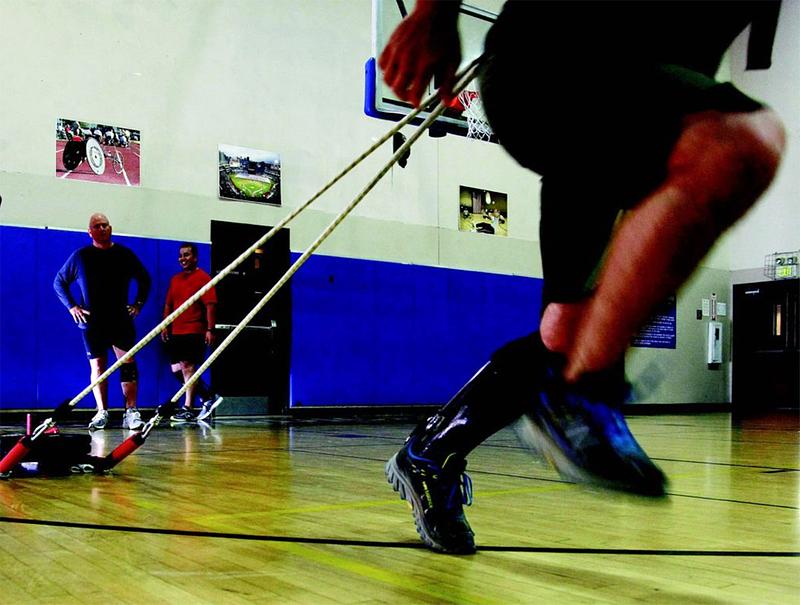Mark's Story
PRIORITI-MTF
 Marine Gunnery Sgt. Mark, far right in the background, participates along with veterans and active-duty service members, in physical therapy at Naval Medical Center San Diego’s gym.
Marine Gunnery Sgt. Mark, far right in the background, participates along with veterans and active-duty service members, in physical therapy at Naval Medical Center San Diego’s gym.
In the years after a roadside bomb in Iraq tore up his right ankle, Mark tried one kind of brace after another. But he found no relief from his chronic pain.
"Believe me, I tried everything," says the 32-year-old Marine sergeant. "It felt like there was really nothing out there for us lower-leg extremity guys."
The war in Iraq was still a relatively new affair in 2004, when Mark was wounded. He wonders sometimes how much of the trouble he endured post-injury is related to the fact that military doctors were still learning their way around the new types of traumatic injuries caused by improvised explosive devices.
"I try to explain sometimes why my situation is different," Mark says. "Most people are used to injuries that come and go. I've had this pain for more than one-third of my life now."
The shrapnel that surgeons in Iraq removed from Mark's leg measured one-and-a-half inches long and three-quarters of an inch thick. Parts of his tibia were blown apart and gone forever. A key tendon was completely severed.
He spent six months in a full leg cast, then two months in a cast that went up to his knee. Two months after that, in a boot. When he finally started therapy, he did so with the confidence and energy you'd expect in a Marine.
"I'm 20 years old at that point, and I'm thinking that I'm young and I'm strong and I'm like Superman, ready to tackle anything," Mark says. "But it just never felt right."
Today, Mark is finally feeling hopeful about his chances to find some relief from the pain he has endured for a dozen years now. His wife was surfing through Facebook one day when she saw a post about a METRC research project called PRIORITI-MTF, and he decided to enroll.
The study was geared toward patients at least two years removed from a traumatic lower leg injury. It gauged the effectiveness of a new type of brace called the Intrepid Dynamic Exoskeletal Orthosis, or IDEO, when used in concert with a physical therapy regimen called Return to Run. Researchers also measured the cost-effectiveness of the device compared with current standards of care.
The study was conducted three military training facilities, including the San Diego Naval Medical Center near Camp Pendleton, where Mark was stationed. As published in the Journal of Bone and Joint Surgery in 2018, results so far illustrate that the new brace, combined with the therapy, is producing moderately successful results. METRC leaders are hopeful the study will be a step on the road to future trials involving civilian patients.
The IDEO brace is a three-part affair. There is a cuff at the knee, a strut running down the calf, and a plate under the foot. All three sections are custom-fitted to each patient and designed to absorb the force of walking and running in ways that ease pressure on the ankle.
"It's molded to my calf, it's molded to my shin, and it's molded to my knee," Mark says. "I can't even tell I'm wearing it, actually."
Kevin Kuhn, an orthopaedic surgeon with the Navy leading the San Diego portion of the trial, says that the specialized physical therapy regimen included in the study was critical to patient outcomes.
"The brace by itself does not necessarily improve performance or make patients happy," he told the San Diego Union Tribune in 2015. "In previous studies, the return-to-duty rate was triple in the people who actually did the Return to Run program."
Mark has put the device through a regimen of daily weight training and a three-mile run. He no longer feels the post-run pain that used to drive him straight to a couch or the bed. Until recently he rarely even felt up to taking his dog for a walk in the morning. Now, for the first time in years he finds himself able to go out on walks along the beach with his wife and take trips to theme parks with his stepchildren. He is cherishes such little joys in life.
Only time will tell if the brace will help Mark meet the physical fitness standards that the Marine Corps requires and hit his goal of a 20-year military career, but "it's been a life changer for me so far," he says.